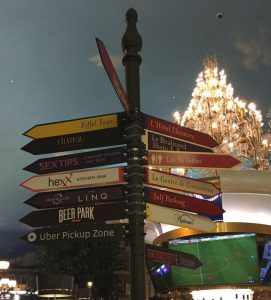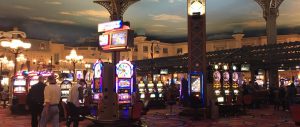Stephanie Bramley is a Research Associate at the NIHR Health and Social Care Workforce Research Unit, King’s College London. (702 words)
Earlier this year I visited Las Vegas with two of my friends. It was my first trip to Las Vegas and as a researcher who explores the impact of gambling for vulnerable people I was somewhat apprehensive about what I may see in Las Vegas. However, the trip provided a good opportunity to explore gambling in ‘Sin City’.
The first thing that struck me was that gambling is synonymous with visiting hotels. The majority of hotels in Las Vegas are ‘gaming hotels’ meaning that they have gambling facilities inside, typically a casino. Indeed the casino is often central to hotel life – meaning that you often have to walk through a casino in order to visit any other part of the hotel. For example, we stayed at the Paris Las Vegas whose check-in desks were situated off to the right-hand side of the casino floor. Furthermore, because of the location of the check-in desks it may be that children and young people may be exposed to gambling activities. We did see a few families in the hotel who were visiting the hotel’s restaurants. Although the official visitor statistics state that fewer children (classified as individuals under 21 years of age) visited Las Vegas in 2017 compared to 2016 (GLS Research, no date).
Another observation is that in the hotels and casinos we visited (i.e. The Bellagio, Caesars Palace, The Venetian, Paris, Hard Rock Cafe) there was a lack of signage – particularly in relation to how to exit the hotel complex or casino (see picture below). This meant that we often had to ask a member of staff for directions to an exit, with the staff member’s response typically being “through the casino”! This combined with some casinos often having dim lighting, a blue sky (in the Paris Hotel, see picture below), no windows and no clocks could contribute to a sense of disorientation, dissociation and losing track of time. This resonates with research conducted by Schüll (2012) who dedicated a chapter of her book to the casino design. We certainly spent plenty of time wandering around, somewhat aimlessly!

As for the gambling experience, we noticed that particular efforts were made to appeal to stereotypical male heterosexual gamblers. For example in the Paris Hotel the uniform for some female members of staff (e.g. croupiers/dealers/waitresses) comprised a bustier or corset with knickers and fishnet tights. Some of these members of staff were also dancing on top of a bar which was located near to gaming tables offering blackjack, roulette and poker. On one evening female members of staff were dressed in football shirts to reflect that the National Football League Conference Playoffs were taking place. We also noticed that females were employed to offer massages to gamblers whilst they were gambling (i.e. at a poker table or slot machine), perhaps as a stress-reducing tactic. Such uniforms and massages may be particularly appealing to some gamblers and provide a welcome distraction from their gambling endeavours.
We also noticed the constant presence of recorded background music in the casinos and instances where live music was sometimes present in the evenings, but in bars close to the casino floor. This corresponds with the findings of my PhD research which found that casino managers in the UK employed recorded background music and live music in casinos (Bramley, 2015). In Vegas, like the UK, live music was often situated away from the casino floor and used to entertain casino visitors. In one particular bar visitors were encouraged by the musicians to dance and sing-along to the music.

Picture of the casino floor in the Paris Las Vegas
Another constant presence within the casinos was the smell of cigarette or cigar smoke. In the UK people are banned from smoking in enclosed spaces, but in Vegas smoking is permitted in many places. This means that members of the public and casino employees are exposed to passive or second-hand smoking. This has led to some casinos investing in air-filtration systems in an attempt to improve air quality in casinos (e.g. Marcus, 2010).
The promotion of responsible gambling was notably absent! We did not see any obvious promotion of, or reference to responsible gambling/gaming (the latter term is how gambling is often described in the USA) at any point during our visit. This contrasts with other casinos that I have visited, for example, in Australia, in Melbourne’s Crown casino there is a “Responsible Gaming Support Centre” which is located inside (Crown Melbourne, no date)

Away from the 4.2 mile long Las Vegas Strip, we visited Downtown Vegas, which has museums and retro casinos. For example, the Golden Nugget casino has the largest piece of gold ever found that weighs 28kg or almost 62lb! In Downtown and Fremont Street we found reminders of old Vegas, for example, there were lots of neon signs (see picture below) although many of the neon signs are now on display at the Neon Museum (Wells & Scott, no date). Gambling was also somewhat cheaper in Downtown Vegas. As an example, the minimum bet was $15 (approximately £11) to play roulette in one casino on the Strip, compared to $5 (approximately £3.80) in Downtown Vegas. The lower minimum bet also applied to slot machines, which could be played for as little as 1¢ per spin (less than a penny!).
All in all, Las Vegas is definitely a city where anything goes! We had an interesting trip and I would like to thank my co-contributors – Amelia Mudd and Sharon Wimbles.
Stephanie Bramley is a Research Associate at the NIHR Health and Social Care Workforce Research Unit, King’s College London.
References
Bramley, S. (2015). Exploring the presence, experience and influence of background music in gambling situations. The University of Sheffield: Sheffield, UK. Available at http://etheses.whiterose.ac.uk/8411/
Crown Melbourne (no date). Responsible Gaming Support Centre. Accessed January 29, 2019, from https://www.crownmelbourne.com.au/getmedia/07a7bb62-4bc8-4ddd-844a-e2f3f3cd2cc6/Crown-Melbourne-Casino-RSG-Support-Centre-Brochure.pdf.aspx
GLS Research (no date). Las Vegas Visitor Profile Study 2017. Accessed January 29, 2019, from https://assets.simpleviewcms.com/simpleview/image/upload/v1/clients/lasvegas/2017_Las_Vegas_Visitors_Profile_Study_1__7b2e5a81-585c-48e6-840c-d7b9face9140.pdf
Marcus, S. (2010, February 14). Despite health risks, casino dealers still exposed to smoke. Las Vegas Sun. Accessed January 29, 2019, from https://lasvegassun.com/news/2010/feb/14/smoky-casino-good-business/
Schüll, N. (2012). Addicted by design: Machine gaming in Las Vegas. Princeton, USA: Princeton University Press.
Wells, D. & Scott, A.J. (no date). Las Vegas’s neon-sign graveyard – in pictures. The Guardian. Accessed January 29, 2019, from https://www.theguardian.com/visit-las-vegas/gallery/2017/apr/19/las-vegass-neon-sign-graveyard-in-pictures